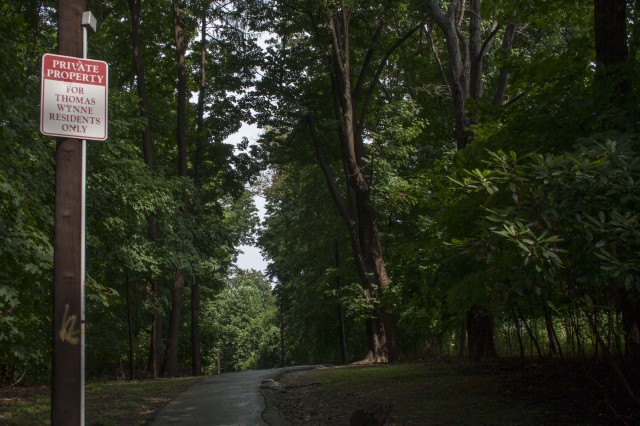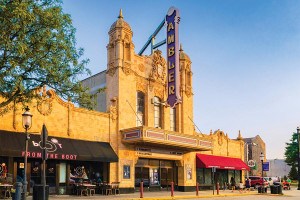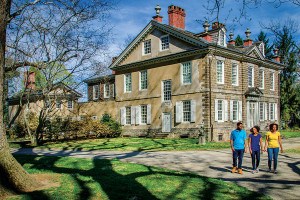250 New Condos Next to Wynnewood Station? Probably.
In November of 2000, Merloc Partners filed plans with Lower Merion Township to build a 280 new condos on the site of the historic Maybrook Estate, located next to the Wynnewood Train Station, a few hundred yards north of the intersection of Wynnewood Road and Penn Road.
Last month a major legal obstacle, which until now was preventing Merloc from implementing its plans, was removed; Merloc and the Borough of Narberth agreed to settle a lawsuit that the developer brought against Narberth in 2002.
Based on a plan that was approved by the Lower Merion Commissioners, Merloc figured on having two points of entry into its development, one on Penn Road (which lets out onto East Wynnewood Road across from a Bed Bath and Beyond), and another on North Wynnewood Ave, near the Narberth Playground. When Merloc’s plan was first made public, Narberth residents were irate. The way they saw it, Lower Merion was going to get more traffic and a lot more new tax revenue. (All of the Maybrook property is in Lower Merion.) Narberth was going to get its share of the traffic too, but without a dime in new taxes to show for it.
Last month, Narberth and Merloc finally reached a settlement. Narberth will allow Merloc to build a limited access private road that can be accessed from North Wynnewood Ave. The agreement also calls for Merloc to make a cash payment to the borough of $325,000. Narberth can use that money in any way it sees fit. In addition, Merloc will contribute $230,000 for a new traffic light and other “improvements” at the intersection of East Wynnewood Road and North Wynnewood Avenue. Many drivers in the community will gladly put up with a few seconds of extra waiting time at the light, in order to avoid the sometimes harrowing experience of working their way through the turn at that location. The improvements are also expected to make the intersection more pedestrian friendly. Last December a 16 year-old girl was hit by a car there, and sustained serious injuries.
Merloc’s plan that was approved by Lower Merion had already required the developer to keep its historic buildings intact. The main building of Maybrook is a 35-room 20,000 square foot mansion. It sits on 17 wooded acres. It is possible to catch a glimpse of the mansion if you drive by it on Penn Road.
Maybrook was built in 1881 for Henry Gibson, and was designed by the prestigious architectural firm of George and William Hewitt, the same team that designed the Belleview-Stratford Hotel. From LowerMerionHistory.org:
Described variably as a Gothic or Elizabethan house, it was clearly English in inspiration and built to impress its visitors.
To have the work done properly, English stonemasons were brought over. When it was completed it had cost $200,000, a grand sum for that era. A 72 foot tower served as a striking landmark to be viewed for miles around. Fountains splashed in front of the house and Victorian gardens with thousands of annuals were its setting.
The suggestion may have been great age, but the comforts were modern…hot-air furnaces and plenty of hot running water. Later, a baronial room which had a court about 60 feet long with a 50 foot ceiling was added. Stained glass windows by Violet Oakley lit the cloistered court, giving it a feeling of part ballroom, part cathedral.
In 1952, real estate developer John W. Merriam bought the eastern part of the Maybrook property from Gibson’s daughter and built the Thomas Wynne House Aparments, which are located in Lower Merion, but they face into Narberth on North Wynnwewood Ave. Merriam acquired the west side of the estate in 1956, and moved into the mansion with his wife Ruth.
The Merriam Theater on Broad Street is named after John Merriam. His best known business venture was the development of the Cedarbrook Hill apartments, a 985- unit high-rise complex in Wyncote, and the Cedarbrook Mall; the first enclosed shopping center in eastern Pennsylvania. He was also a large contributor to several political campaigns.
Ruth Merriam died in 1988. In 1992 Merriam married Elizabeth (Betty) Lockyer. Ms. Lockyer had been Merriam’s secretary for forty years prior to their marriage. She had a son, Robert Lockyer, from another marriage that ended in divorce. Merriam died in 1994, without a will. His estate was valued at $95 million.
The Inquirer reported:
A longtime patron of the arts, Merriam intended to leave most of his estate to four Philadelphia-area arts and educational institutions. He wrote a will to that effect in 1990, after the death of his first wife. But under Pennsylvania law, the 1990 will was nullified when Merriam remarried in 1992.
When he died at age 86 in 1994, his widow appeared to be the sole heir, entitled to the entire $95 million estate. The legal quirk might have dealt a terrible blow to Merriam’s favorite charities. But it didn’t turn out that way. Rather than lay claim to all the money, Betty Lockyer Merriam, a good-humored and unpretentious woman, did what she had done for decades as her husband’s secretary: She carried out his plan.
In November of 2000, only four months before she died, Ms. Merriam transferred the Maybrook property to Merloc Partners, which was headed by her son Robert. In the same month, Merloc filed its plan for the subdivision.
The neighbors did not throw rose petals on Lockyer’s doorstep to show their appreciation for his inspired concept which called for five new buildings. In May of 2001, members of the Wynnewood Civic Assocation unearthed a deed restriction that said the property’s owners could not build more three apartments on the site. So Merloc‘s design team had to go back to drawing board. (Or maybe by that time they were already using CAD software.)
In November of 2001, The Inquirer’s esteemed architecture critic, Inga Saffron, weighed in on behalf of Merloc.
She wrote:
You would think that any project that features historic preservation, anti-sprawl efforts, and open space would sail through the planning process. But Merlock has been negotiating for more than a year now…
Merlock only made its first public presentation to the Lower Merion Planning Commission on Nov. 15. At that meeting, angry neighbors from the Narberth Civic Association complained that the project would result in a traffic nightmare and suggested that Merlock instead fill the 44 acres with single-family homes. In the context of modern-day realities, that represents the fanatic position. The lawns along Maybrook’s border on North Wynnewood Avenue have been planted with protest signs declaring, ungrammatically, “No exit Merriam development.” Building this kind of high-density housing near transit lines happens to be the holy grail of New Urbanist thinkers. Their term for such projects is Transit-Oriented Development.
In 2002 Lower Merion approved Merloc’s plan. Narberth promptly sued Lower Merion, and passed a driveway ordinance which prohibited Merloc from having its access road empty out onto North Wynnewood Ave. At the same time, Merloc sued Narberth. Since then, the case has oscillated in legal purgatory and the development project has been on hold.
There is a very pretty, secluded trail that connects the Thomas Wynne Apartments to the Wynnewood Train Station. Until now the pathway has been for the exclusive use of Thomas Wynne Apartment residents, however, the Narberth-Merloc agreement calls for giving the public access to the trail.



